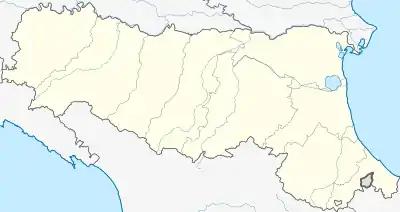Fontanellato
Fontanellato (Parmigiano: Funtanlè) is a small town in the province of Parma, in northern Italy. It lies on the plains of the River Po near the A1 autostrada, about 20 kilometres (12 mi) west of Parma towards Piacenza.
Fontanellato | |
|---|---|
| Comune di Fontanellato | |
 Sanctuary of Beata Vergine del santo Rosario | |
 Coat of arms | |
Location of Fontanellato 
| |
 Fontanellato Location of Fontanellato in Italy  Fontanellato Fontanellato (Emilia-Romagna) | |
| Coordinates: 44°53′N 10°11′E | |
| Country | Italy |
| Region | Emilia-Romagna |
| Province | Parma (PR) |
| Frazioni | Albareto, Cannetolo, Casalbarbato, Ghiara, Ghiara Sabbioni, Grugno, Parola, Paroletta, Priorato, Rosso, Sanguinaro, Toccalmatto |
| Government | |
| • Mayor | Francesco Trivelloni |
| Area | |
| • Total | 53 km2 (20 sq mi) |
| Elevation | 45 m (148 ft) |
| Population (31 May 2007)[2] | |
| • Total | 6,624 |
| • Density | 120/km2 (320/sq mi) |
| Time zone | UTC+1 (CET) |
| • Summer (DST) | UTC+2 (CEST) |
| Postal code | 43012 |
| Dialing code | 0521 |
| Website | Official website |
The town was built up in the 15th century around the moated and fortified house of the Sanvitale family, the Rocca Sanvitale, on the borders of the domain of the Dukes of Parma. The house was occupied by the family until 1951, when it was sold to the commune. One notable feature of the Rocca Sanvitale is a room which serves as a large Camera Obscura in which a small hole acts as a lens causing an image of an outside scene to be projected inside the room.
The shrine to the Madonna del Rosario commemorates a succession of miracles beginning in 1628.
The town is also "Labarinto della Masone", once the largest Maze in the world and built by native son Franco Maria Ricci totally from Bamboo.[3]
WW2 POW camp
During World War II, a large brick building with stone facings and neo-classical features next to the Sanctuary of the Blessed Virgin of the Holy Rosary, intended for an orphanage (but never used as such), was the prisoner-of-war camp PG (Prigioniero di Guerra) 49. From here 600 Allied officers and men escaped, thanks to the decision by the Commandant, Colonel Eugenio Vicedomini, to open the gates the day after the Armistice of 8 September 1943.[4][5]
On 6–9 September 2013, to celebrate the 70th anniversary of this event a conference was held in the Rocca on prisoners of war in World War II, with other celebrations and commemorations, jointly by the town and the Monte San Martino Trust. One of the escaping prisoners was the English writer Eric Newby, who memorably detailed his escape and subsequent experiences in the 1971 memoir, Love and War in the Apennines.[6][5][7][8][9]
The building is now a centre for neurological disorders.
References
- "Superficie di Comuni Province e Regioni italiane al 9 ottobre 2011". Istat. Retrieved 16 March 2019.
- All demographics and other statistics: Italian statistical institute Istat.
- https://www.apartamentomagazine.com/stories/franco_maria_ricci/
- Note: Colonel Vicedomini was imprisoned in Germany as a result of this act of humanity and died soon after the war.
- Newby, Eric (1971). Love and War in the Apennines.
- English, Ian (1997). Home by Christmas?. Revised and reprinted 2017.
recounts the remarkable adventures experienced by some of the 600 prisoners of war who marched out of camp PG49 at Fontanellato after the Armistice on September 8th 1943
Obit of Ian English - Carver, Tom (June 2010). Where the hell have you been?. Allen & Unwin. Excerpt
- Tudor, Malcolm (2009). Beyond The Wire - A True Story of Allied POWs in Italy 1943-1945. Emilia Publishing. ISBN 9780953896455.
- Clarke, Jack (29 September 2012). "Not too much hardship at Fontanellato". Birmingham Post. Archived from the original on 29 September 2012. Retrieved 23 August 2020.
External links
- Fontanellato tourist office (in Italian)
- Comune di Fontanellato (in Italian)
- History of Fontanellato
